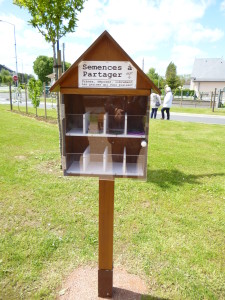Pam Warhurst and Joanna Dobson’s book on the Incredible Edible was my holiday book last summer. The wealth and details accounting for stages, encountered difficulties and envisaged solutions soon appeared to be a crucial case to analyse and try and understand the dynamics behind citizens’ movements which seek to improve the world.
Throughout the world, the Incredible Edible movement represents groups of citizens planting in towns and in walking areas, giving free access to herbs and plants to all. These are sometimes rich and beautiful gardens, inviting walker to help themselves, sometimes they seems abandoned. Some people complain about the fact that planting next to the road or in wheels is unpretty and worst for health than products from (conventional) agriculture. All in all, it launches debate and acts for (re) action.
The book on the birth and raise of Incredible Edible in Todmorden reflects on the (sometimes lack of) strategies, long-term visions, the dynamics between people organisations… In short, all that make a bottom-up citizens’ initiatives movement work – or not – but at least worth giving it a try. The value of this insight is to get a few learnings, amongst which:
- That each project can (SHOULD !) be launched without a predefined strategy or project. An idea is sufficient to start testing an approach. The Incredible Edibles where at first an idea, a wish to create a better world, yet with an great ambition, still with the simple idea that planting edibles in an garden accessible to all would take an international or cross-sectoral dimension, but that SOMETHING would happen.
- That the goal of the initiative should not necessarily be “sustainability” or “saving the planet”, but, for example, recreating links within society. Urban resiliency can take many forms and each entry point can lead to the others in an organic way. The Incredible Edibles made small, then big, projects, to gain trust and visibility from the community , all supported by a strong goodwill, a “letting go” approach, far for making community members feeling guilty about the state of the world.
- That a community can take shape as soon as the individual motivations are supported enough to attract other compatible and complementary people. The Incredible Edibles started from a discussion between two passionate people, ready to open their own private garden to passing by inhabitants.
- That acting is a stronger driver than questioning: these impose themselves once a project is launched, but then, they also find answers more easily. The members of the Incredible Edibles found easier funding once their projects were clear or already set up. One explanation can be that not only was the motivation to look efficiently for funding but also more justifiable.
- That experimenting can take place beyond the legal framework. Far from being in illegality, experimentation can take advantage of grey or previously unruled zones. The Incredible Edibles thus planted in places not originally foreseen for such an activity but for which they obtained later an authorisation. They also tested and experimentation on scholar and vocational training programmes before integrating them to official curricula.
- That size does not matter. A small project might remain small or grow. It might evolve in a pre-defined frame or evolve independently. It might reinforce over time or change drastically. The Incredible Edibles cooperate with a variety of other activities and movements. They also spawned other social, pedagogical, training and economic activities. Not all are labelled “Incredible Edible” but the movement did contribute their upcoming.
- That a movement needs to have a red thread with (a) general objective(s). The Incredible Edibles combined its societal, educational and economic aspirations which ensured its continuation and equilibrium over time.
- That food federates and has a social and economic potential, far beyond a pure functional role. The Incredible Edibles spread about in various fields of Todmorden’s life, increasing economic and personal well-being of the inhabitants through empowerment, training, creation of social links and solidarity, and more than anything else, proposing common values realised in a joint project.
- And that more than anything else, goodwill is the key for such a movement. Being in a state of mind where each person is ready to test, take personal and collective risks. To share, listen and learn. To be punched and to rebound. Not to see an obstacle as an end in itself but a way of adopting a new approach. In itself, goodwill as lived in Todmorden has contributed to individual, social and societal resilience. To the same the level than to environmental as well as economic resilience.
As a passive or proactive reader, this book is worth opening. It is an inspiration for citizens, an example that change can happen, a manual for those wanting to make this change happen and for those seeking to understand the way change can happen. As both a citizen and a professional, this book has inspired me greatly. It is the starting point of a citizens’ movement to revitalise a small park and playground in Brussels. I am now making my own experience – and observation – as a citizen in a participatory movement, as well as a professional seeking to trigger cooperation with the city council. The future will now tell us what can arise out of it. Experimentation will in any case make tings evolve and is worth trying, isn’t it?



